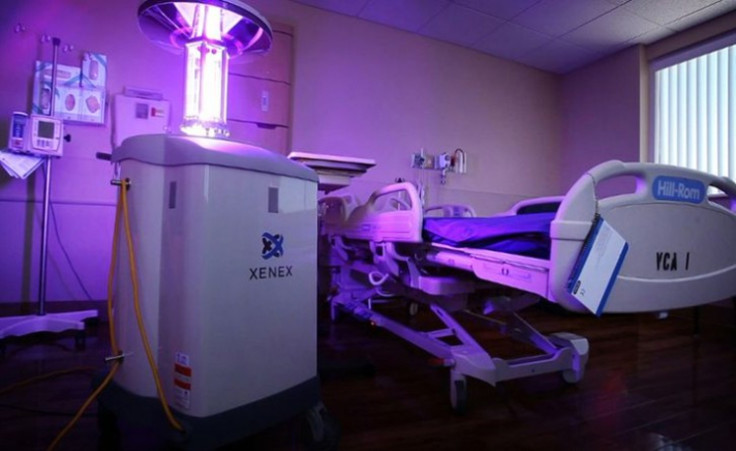Ebola: Can Robots Save the World from Killer Virus?

Over 250 hospitals in the US are using a robot that can rid a hospital room of all mould, germs and viruses including Ebola, MRSA, C.diff, norovirus, influenza and staph bacteria within 15 minutes using ultraviolet (UV) rays.
The Centers for Disease Control and Prevention (CDC) says over 75,000 people in the US die every year from hospital-acquired infections, or healthcare associated infections (HAIs).
In the UK, the National Institute for Health and Care Excellence (Nice) says 300,000 patients contract infections from NHS wards and 5,000 die a year from superbugs, due to poor hygiene among staff and dirty hospital equipment.
Xenex disinfection system
The Xenex robot is just over three feet tall and makes use of pulsed UV-C rays, a type of UV mostly filtered out by the Earth's ozone layer.
The rays are 25,000 times brighter than the sun, produced by passing electricity through ionised xenon gas at high pressure.
The resulting pulses emit UV-C light at multiple frequencies, which is strong enough to damage microorganisms so cells cannot be replicated, since the germs are susceptible to UV damage in a wide range from 200 to 280 nanometres.
The process involves a hospital worker wheeling the machine into the middle of a room and then leaving it on its own. The robot then emits pulses of UV-C light until the room is disinfected.
The light cannot pass through walls, doors or safety glass but it can be slightly irritating to human eyes, so workers are advised to wait outside until the robot is done. A grey safety cone is also provided with the robot that can detect motion and turn the machine off.
Pulsed Ultraviolet-C rays
Pulsed UV light technology has existed since the 1970s but required the use of mercury bulbs, which are toxic and provide only a very narrow spectrum of light, meaning they cannot kill many germs at a time.
This means xenon lamps using mercury bulbs require longer exposure times and lengthen cleaning times, so hospitals have continued the traditional practice of disinfecting surfaces by wiping them down with bleach.
The Xenex room disinfection system, which uses 100% green xenon gas, is designed to go round hospital rooms after human cleaners are done.
The robot is the brain child of Xenex Disinfection Services, a Texas-based company founded in 2008 by Dr Mark Stibich and Dr Julie Stachowiak, two epidemiologists who were working overseas on public health interventions and research when they learned of air disinfection technology being used to combat airborne tuberculosis.
When they realised how the technology could be used to solve hospital-based infections, Stibich and Stachowiak began working on a robot that could kill organisms using pulses of light.
"Everyday 275 die from infections at hospitals so we wanted to take that technology and do something about it," Stibich, chief scientific officer at Xenex told local Dallas TV channel CBS 11 News.
"It's very difficult to clean every square inch of a room. The robot does that with light."
Good results already being seen
Hospitals and independent laboratories have been testing out successive versions of the robot since 2010 and studies have shown the Xenex system is 20 times more effective in killing dangerous pathogens than traditional housekeeping methods.
Six hospitals have also reported between 20-62% reduction in bacterial contamination as well as MRSA and C.diff infection rates after using the robot.
"Six peer-reviewed studies have been published supporting the efficacy of the Xenex technology, including three where Xenex customers reported significantly reduced HAI rates after implementing the Xenex robot for room disinfection," Stibich testified before the US House of Representatives Science Committee in June.
"No other UV technology has peer-reviewed studies demonstrating the impact of the technology on actual patient infection rates. Furthermore, the Xenex germ-zapping robot is cost-effective and produces a significant ROI.
"We believe Congress has an opportunity to meaningfully improve the health of its veterans and citizens by promoting policies that accelerate the adoption of technologies that can effectively disinfect the hospital environment."
© Copyright IBTimes 2025. All rights reserved.






















